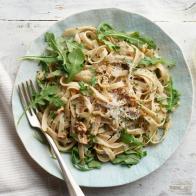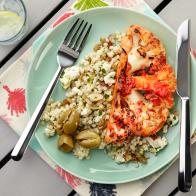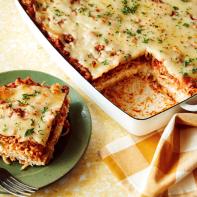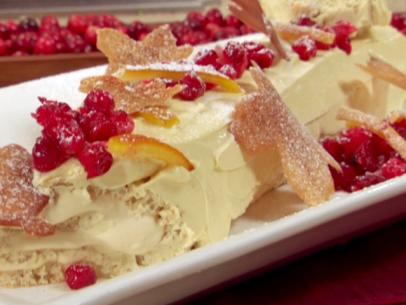
Recipe courtesy of
Jacqueline Tris
for
Food Network Kitchen
Recipe courtesy of
Jacqueline Tris
for
Food Network Kitchen
Watch how to make this recipe.
Pan de Muerto
Getting reviews...
- Level: Intermediate
- Total: 4 hr 35 min (includes rising times)
- Active: 1 hr
- Yield: 12 breads
-
- Nutritional Analysis
- Per Serving
- Serving Size
- 1 of 42 servings
- Calories
- 212
- Total Fat
- 15 g
- Saturated Fat
- 3 g
- Carbohydrates
- 16 g
- Dietary Fiber
- 1 g
- Sugar
- 4 g
- Protein
- 3 g
- Cholesterol
- 28 mg
- Sodium
- 32 mg
Día de los Muertos is a time of tradition, honoring family and making and bringing offerings for loved ones no longer with us. Pan de muerto plays an integral role during the holiday — serving both as an offering to honor those who have passed as well as a pan dulce (sweet bread) to enjoy during the celebration. The breads are often adorned with two strips of dough on top arranged in a cross pattern — representing crossbones — with a ball of dough in the center, most commonly representing a skull but sometimes signifying a heart or a tear shed for loved ones. Orange and anise are traditional flavorings, though I've made the anise seeds optional here, and decorating with sugar or sesame seeds on top is lovely but also optional.
- Level: Intermediate
- Total: 4 hr 35 min (includes rising times)
- Active: 1 hr
- Yield: 12 breads
-
- Nutritional Analysis
- Per Serving
- Serving Size
- 1 of 42 servings
- Calories
- 212
- Total Fat
- 15 g
- Saturated Fat
- 3 g
- Carbohydrates
- 16 g
- Dietary Fiber
- 1 g
- Sugar
- 4 g
- Protein
- 3 g
- Cholesterol
- 28 mg
- Sodium
- 32 mg
Ingredients
Dough:
Topping:
Directions
- For the dough: Add the milk and 1 tablespoon of the granulated sugar to a small saucepan. Heat over medium-low heat until the sugar dissolves and the temperature registers between 100 and 110 degrees F. Remove from the heat and stir in the yeast. Let stand until the yeast blooms and the mixture is frothy and bubbly, about 10 minutes.
- Combine the flour, cinnamon, salt, orange zest, anise, if using, and remaining 1/2 cup granulated sugar in a stand mixer with a dough hook attachment on low speed. Gradually add the yeast mixture. Add the orange blossom water, vanilla and eggs and mix until a scrappy dough forms, about 5 minutes. Increase the speed to medium and gradually add the butter in tablespoon increments, making sure the butter is incorporated before adding more. Increase the speed to medium high and mix, stopping and checking the dough occasionally, until elastic and slightly sticky, 10 to 15 minutes.
- Knead the dough by hand on a lightly floured surface, just enough to shape it into a ball and make sure it is no longer sticky, 1 to 2 minutes. Lightly oil a large bowl, add the dough and cover with a damp cloth or plastic wrap. Place the bowl in a warm area, away from drafts, until the dough is doubled in size, about 1 hour.
- Divide the dough into portions of roughly two-thirds for the breads and one-third for the decorations. Divide the larger portion into 12 pieces, each about 60 grams, and shape into rounds. Arrange on 2 parchment-lined baking sheets.
- Add about 2 tablespoons of flour to the remaining portion of dough and knead by hand until no longer sticky, 5 to 8 minutes. Divide the dough into 12 pieces, each about 40 grams. To make the skull and crossbones decorations, divide 1 dough piece into 3 smaller pieces. Roll 2 of the 3 pieces into logs, pressing 3 of your spread fingers into the logs to flatten and make indentations in the strips; these will be the crossbones. Cross the 2 dough strips on top of one of the bread rounds. Roll the third dough piece into a ball and place it in the center of the crossed strips; this will represent the skull. (If the skull or crossbones aren't sticking, use a bit of water to adhere them.) Repeat with remaining dough pieces. Lightly cover the breads with plastic wrap and let rest until doubled in size, about 2 hours.
- Position oven racks in the top and bottom thirds of the oven and preheat to 350 degrees F.
- For the topping: Beat the egg with 1 tablespoon water in a small bowl to make an egg wash. Brush the tops of the bread with the egg wash and sprinkle with the sesame seeds, if using.
- Bake, rotating the baking sheets from top to bottom halfway through, until the breads are slightly golden brown, 20 to 25 minutes. Let cool slightly on wire racks.
- To decorate the breads with sugar, brush the tops with the melted butter and sprinkle with the sanding sugar.
































